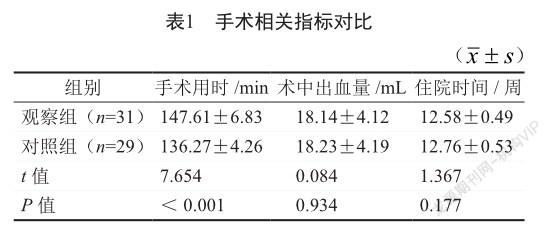经皮空心螺钉固定与支撑钢板对后踝骨折患者踝关节功能及活动度的影响对比
黄家云 李根华



摘 要 目的:对比经皮空心螺钉固定与支撑钢板对后踝骨折患者踝关节功能及关节活动度(ROM)的影响。方法:回顾性分析60例后踝骨折患者临床资料,将采用经皮支撑钢板固定治疗的患者归为观察组(n=31),将采用经皮空心螺钉固定治疗的患者归为对照组(n=29)。对比两组手术相关指标与术前、出院后3个月踝关节功能及ROM变化情况。结果:两组术中出血量与住院时间比较无统计学意义(P>0.05);与对照组比较,观察组手术用时较长(P<0.05)。出院后3个月,两组美国足踝外科协会踝-后足评分均较术前上升,且观察组上升幅度较大(P<0.05);两组ROM均较术前上升(P<0.05)。结论:后踝骨折患者采用经皮支撑钢板固定治疗效果优于空心螺钉固定,可促进踝关节功能恢复。
关键词 后踝骨折 经皮空心螺钉固定 支撑钢板 踝关节功能 关节活动度
中图分类号:R683.42 文献标志码:B 文章编号:1006-1533(2021)19-0032-03
Effect of percutaneous cannulated screw fixation and support plate on ankle joint function and range of motion in patients with posterior malleolus fracture
HUANG Jiayun, LI Genhua
(Department of Orthopaedics, Traditional Chinese Medicine Hospital of Xingan County, Jian 331300, China)
ABSTRACT Objective: To compare the effects of percutaneous cannulated screw fixation and support plate on ankle joint function and range of motion (ROM) in patients with posterior malleolus fracture. Methods: The data from 60 patients with posterior malleolus fracture were retrospectively analyzed and the patients were divided into an observation group (treated with percutaneous plate fixation, n=31) and a control group (treated with percutaneous hollow screw fixation, n=29). The changes of ankle joint function and ROM were compared between the two groups before operation and three months after discharged from hospital. Results: There were no significant differences between the two groups in intraoperative blood loss and hospitalization time (P>0.05). Compared with the control group, the observation group had a longer operative time (P<0.05). The ankle-hindfoot scores of the American Foot and Ankle Surgery Association in both groups were higher three months after discharged from hospital than those before operation, and furthermore the increase in the observation group was greater (P<0.05). The ROMs of both groups were increased after operation (P<0.05). Conclusion: The effect of percutaneous plate fixation for posterior malleolus fracture is better than that of cannulated screw fixation.
KEy wORDS posterior malleolus fracture; percutaneous hollow screw fixation; support plate; ankle joint function; joint range of motion
后踝骨折作为一种临床常见骨折疾病多发于青壮年群体,既往临床常采用传统切开复位治疗此疾病,但此治疗方式对于患者机体创伤较大,且术后并发症较多,已不适于现代微创理念[1]。内固定治疗是近些年逐渐兴起的治疗方式,主要内固定材料有空心螺钉与支撑钢板,两种材料均可有效起到固定骨折作用[2-3]。目前对两种材料固定对于后踝骨折患者踝关节功能与关节活动度(range of motion, ROM)的专项研究较少,鉴于此,本研究旨在对比两种固定材料对于后踝骨折患者临床疗效的影响。
1 資料与方法
1.1 一般资料
回顾性分析我院骨科2017年1月—2020年4月收治的60例后踝骨折患者临床资料,将采用经皮支撑钢板固定治疗的患者归为观察组(n=31),将采用经皮空心螺钉固定治疗的患者归为对照组(n=29)。观察组中男19例,女12例;年龄26~57岁,平均年龄(40.32±3.17)岁;骨折位置:左侧骨折16例,右侧骨折13例,双侧骨折2例;骨折原因:交通事故20例,高处摔伤9例,外力打击2例;后踝骨折Haraguchi分型[4]:Ⅰ型8例,Ⅱ型13例,Ⅲ型10例;三踝骨折12例,双踝骨折19例。对照组中男18例,女11例;年龄24~58岁,平均年龄(40.25±3.19)岁;骨折位置:左侧骨折15例,右侧骨折12例,双侧骨折2例;骨折原因:交通事故19例,高处摔伤8例,外力打击2例;后踝骨折Haraguchi分型:Ⅰ型8例,Ⅱ型12例,Ⅲ型9例;三踝骨折11例,双踝骨折18例。本研究经院内医学伦理委员会批准。两组一般资料对比差异无统计学意义(P>0.05),有可对比性。

